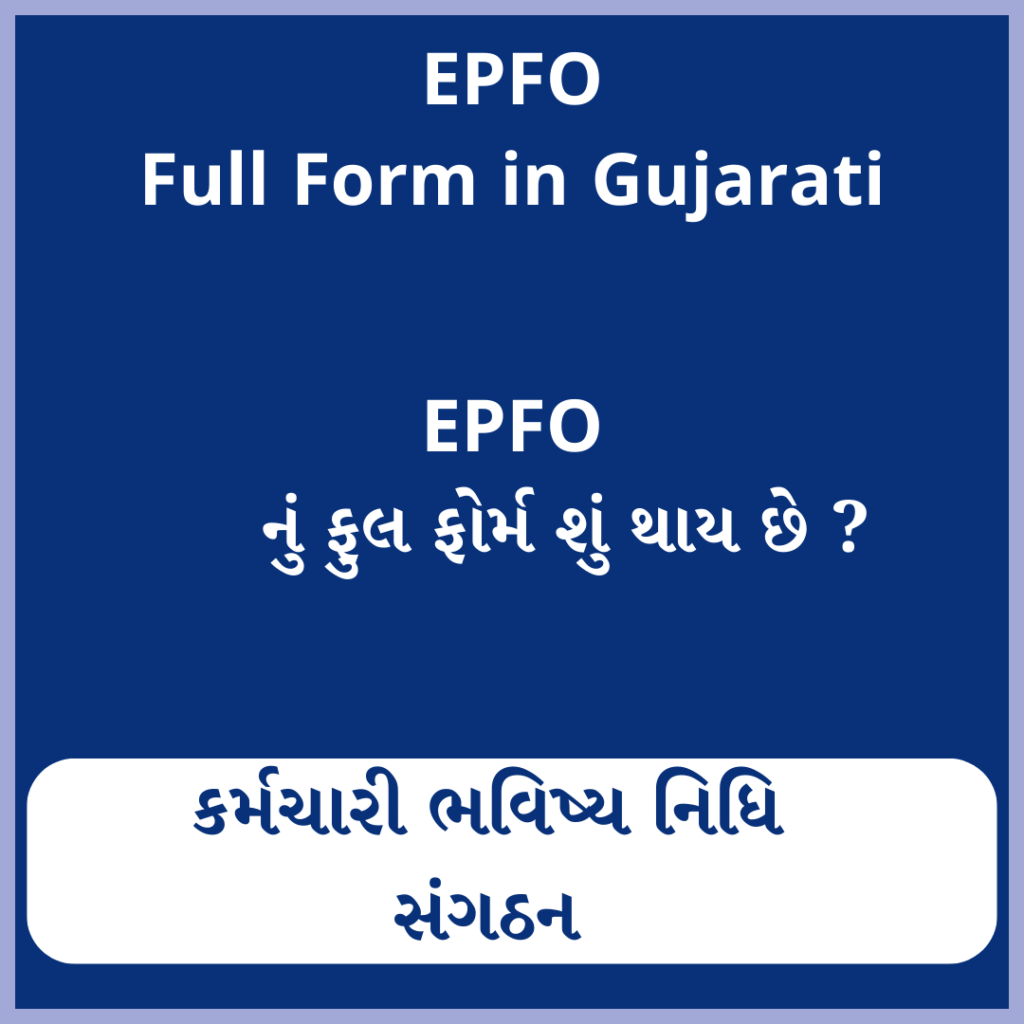What is the Full form of PF in Gujarati?
The Full form of PF in Gujarati is કર્મચારીઓની ભવિષ્ય નિધિ સંસ્થા ( Employees’ Provident Fund Organisation ).
PF નું પૂર્ણ સ્વરૂપ Employees’ Provident Fund Organization છે, અને તેનો ગુજરાતીમાં અનુવાદ થાય છે કર્મચારીઓની ભવિષ્ય નિધિ સંસ્થા. તે એક વૈધાનિક સંસ્થા છે જે ભારત સરકારના CBT (સેન્ટ્રલ બોર્ડ ઓફ ટ્રસ્ટીઝ) ને મદદ કરવા માટે રચાયેલ છે. તેની સ્થાપના વિવિધ જોગવાઈ અધિનિયમ, 1952 અને કર્મચારી ભવિષ્ય નિધિ દ્વારા કરવામાં આવી છે. તે ભારત સરકારના શ્રમ અને રોજગાર વિભાગના વહીવટી અધિકારક્ષેત્ર હેઠળ છે. દેશભરમાં વિવિધ સ્થળોએ તેની લગભગ 122 ઓફિસો છે.
અરજદારોની સંખ્યા અને નાણાકીય વ્યવહારોના આધારે, EPFO એ ભારતની સૌથી અગ્રણી સામાજિક સુરક્ષા સંસ્થાઓમાંની એક છે. તે ફરજિયાત ભવિષ્ય નિધિ યોગદાન કાર્યક્રમના સંચાલનમાં કેન્દ્રીય બોર્ડને સમર્થન આપે છે. તે દ્વિપક્ષીય સામાજિક સુરક્ષા કરારો લાગુ કરવા માટે અન્ય રાષ્ટ્રો માટે નોડલ એજન્સી તરીકે પણ કામ કરે છે.
EPFO નો સંક્ષિપ્ત ઇતિહાસ

કર્મચારી ભવિષ્ય નિધિ વટહુકમ 1951માં અસ્તિત્વમાં આવ્યો જે પાછળથી કર્મચારી ભવિષ્ય નિધિ અધિનિયમ 1952 દ્વારા બદલવામાં આવ્યો. આ કેસ 1952ના કર્મચારી ભવિષ્ય નિધિ અને પરચુરણ જોગવાઈ અધિનિયમ તરીકે ઓળખાય છે. તે જમ્મુ રાજ્ય સિવાય સમગ્ર ભારતમાં લાગુ પડે છે. અને કાશ્મીર
EPFO નું માળખું
સંસ્થા ભારતમાં ઘણા ઝોનમાં વિભાજિત છે, જેનું નેતૃત્વ અધિક કેન્દ્રીય ભવિષ્ય નિધિ કમિશનર કરે છે.
પ્રાદેશિક ભવિષ્ય નિધિ કમિશનર, ગ્રેડ Iની આગેવાની હેઠળ ઓછામાં ઓછી એક પ્રાદેશિક એજન્સી દરેક રાજ્ય માટે જરૂરી છે.
પ્રાદેશિક ભવિષ્ય નિધિ કમિશનર, ગ્રેડ II દ્વારા સંચાલિત વિવિધ પ્રદેશોમાં સંસ્થાને વધુ પેટાવિભાજિત કરવામાં આવી છે.
મોટાભાગના વિસ્તારોમાં, EPFO એ સ્થાનિક સંસ્થાઓ પર દેખરેખ રાખવા અને ફરિયાદોનું નિરાકરણ કરવા માટે પાલન અધિકારી સાથે જિલ્લા કચેરીઓ પણ સ્થાપી છે.
EPFO દ્વારા ઓફર કરવામાં આવતી સેવા
નોકરીદાતાઓના કિસ્સામાં
- સ્ટાફ માટે UAN સભ્ય ઈ-સેવા.
- ઑનલાઇન UAN સ્ટેટસ પ્રદાન કરે છે.
- સ્ટાફની EPFO ફરિયાદ વ્યવસ્થાપન સિસ્ટમ.
- ટ્રાન્સફર ક્લેમ ઓનલાઈન સબમિશન માટે ઓનલાઈન ટ્રાન્સફર ક્લેઈમ પોર્ટલ.
- EPFO પોર્ટલ પર ડેટા સાચવવા માટે COC વિનંતી ફોર્મ.
- પેન્શનને લગતી માહિતી અથવા માહિતીને ઍક્સેસ કરવા માટે પેન્શન ફંડ પ્લેટફોર્મ.
- નિષ્ક્રિય ખાતાઓ મદદ ડેસ્ક સપોર્ટ.
નોકરીદાતાઓના કિસ્સામાં
- સ્થાપનાની ઓનલાઈન નોંધણી
- UAN ((યુનિવર્સલ એકાઉન્ટ નંબર)ની માહિતી આપે છે
- EPF સબ્સ્ક્રિપ્શન માટે ઑનલાઇન ચુકવણી
- ચલણનું ઓનલાઈન સબમિશન અથવા ECR સબમિશન
- EPFO ફરિયાદ વ્યવસ્થાપન સિસ્ટમ
- ઓનલાઈન ટ્રાન્સફર ક્લેમ પોર્ટલ
EPFO દ્વારા અમલમાં મૂકાયેલ કાર્યક્રમો
EPFO દ્વારા અમલમાં મુકવામાં આવેલ વિવિધ કાર્યક્રમો અથવા યોજનાઓ છે:
- કર્મચારી પેન્શન યોજના
- EPF (કર્મચારી ભવિષ્ય નિધિ યોજના)
- EDLI (કર્મચારીની ડિપોઝિટ લિંક્ડ વીમા યોજના)